Unit- I: Introduction to E- Commerce
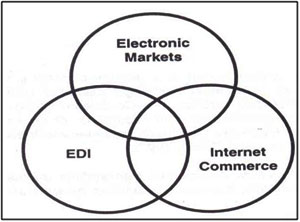
It is sharing business information, maintaining business relationships and conducting business transactions using computers connected to a telecommunication network is called E-Commerce.
OR
The exchange or buying and selling of commodities on a large scale involving transportation from place to place is known as commerce. When all this is done electronically, it is known as “e-commerce”.
According to Philip Kotler:
E-commerce can be defined as a general term for buying and selling process that is supported by electronic means.
E-commerce, also known as E-business, a term applicable for all kinds of business, that are established electronically especially over the Internet. This includes both electronic sale (internet shops) and B2B transactions, i.e. business between two companies. It is any online transaction of buying and selling where business is done via Electronic Data Interchange (EDI).
Examples:
- Retail Stores - Books, Music
- Auction Sites
- Cooperating Businesses –Placing Orders, Paying Invoices Etc.
- Electronic Banking
- Booking Tickets - Trains, Cinema, Airlines
- Electronic Publishing
- Filling Tax Returns with Government Dept.
E-Commerce Features:
- Buying and selling products and services on the Internet.
- The sellers vary from individuals to small businesses to large corporations.
- The buyers are consumers or businesses.
- Payment can be made by credit or debit card, money order, cash, check, services or trade.
- E-Commerce helps in lowering both orders taking cost and customer service costs.
- The ranges of things that can be sold using e-commerce is enormous and include art, apartment, antennas, batteries, bicycles, books, cars, cells phones, computer, cosmetics and whatever else can change hands.
History of E-Commerce
| Year | Event |
| 1984 | EDI, or electronic data interchange, was standardized through ASC X12. This guaranteed that companies would be able to complete transactions with one another reliably. |
| 1992 | CompuServe offers online retail products to its customers. This gives people the first chance to buy things off their computer. |
| 1994 | Netscape arrived. Providing users a simple browser to surf the Internet and a safe online transaction technology called Secure Sockets Layer. |
| 1995 | Two of the biggest names in e-commerce are launched: Amazon.com and eBay.com. |
| 1998 | DSL, or Digital subscriber Line, provides fast, always on Internet service to subscribers across California. This prompts people to spend more time, and money online. |
| 1999 | Retail spending over the Internet reaches $20 billion, according to Business.com. |
| 2000 | The U.S government extended the moratorium on Internet taxes until at least 2005. |
They can be classified by application type:
- Electronic Markets
- Present a range of offerings available in a market segment so that the purchaser can compare the prices of the offerings and make a purchase decision.
Example: Airline Booking System
- Present a range of offerings available in a market segment so that the purchaser can compare the prices of the offerings and make a purchase decision.
- Electronic Data Interchange (EDI)
- It provides a standardized system
- Coding trade transactions
- Communicated from one computer to another without the need for printed orders and invoices & delays & errors in paper handling
- It is used by organizations that a make a large no. of regular transactions
Example: EDI is used in the large market chains for transactions with their suppliers
- Internet Commerce
- It is used to advertise & make sales of wide range of goods & services.
- This application is for both business to business & business to consumer transactions. Example: The purchase of goods that are then delivered by post or the booking of tickets that can be picked up by the clients when they arrive at the event
- Scope of E-Commerce:
- Internet e-commerce is one part of the overall sphere of e-commerce.
Figure: Three categories of E-commerce
- Internet e-commerce is one part of the overall sphere of e-commerce.
- Electronic Commerce and the trade cycle:
- It can be applied to all, or to different phases of the trade cycle
- The trade cycle varies depending on the nature of the organizations frequency of trade between the patterns to the exchange and the nature of goods and services being exchanged
- Trade cycle support
- Finding goods and services (referred to as a search & negotiation)
- Placing the order, taking delivery & making payment (execution and settlement)
- After sales activities such as warrantee, services etc.
The three generic trade cycles can be identified:
- Regular, repeat transactions (repeat trade cycle)
- Irregular transactions, where execution & settlement are separated (credit transactions)
- Irregular transactions where execution & settlement are combined (cash transactions)
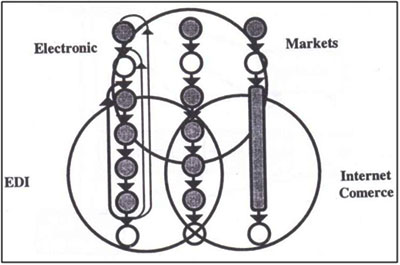
Figure: E-Commerce Technologies and generic trade cycles
Electronic Markets:
- It increases the efficiency of the market
- It reduces the search cost for the buyer & makes it more likely that buyer will continue the search until the best buy is found
- It exist in commodity, financial markets & they are also used in airline booking system
- It is irregular transaction trade cycle.

Electronic Data Interchange:
- It is used to trade exchanges
- Users are vehicle assemblers, ordering components for the supermarkets
- It is used for regular repeat transactions
- It takes quite lot of work to set up systems
- It is part of schemes for just-in-manufacture and quick response supply
- Mature use of EDI allows for a change in the nature of the product or service
- Mass Customization is such an example
Internet Commerce:
The first stage
- Advertising appropriate goods and services
- Internet sites offer only information & any further steps down the trade cycle are conducted on the telephone
The Second stage
- An increasing no. of sites offer facilities to execute & settle the transaction
- Delivery may be electronic or by home delivery depending on the goods and services
The final stage
- After-sales service
- On-line support & On-Line services.

3. Electronic Commerce Framework
E-Commerce application will be built on the existing technology infrastructure
- A myriad of computers Communication networks Communication software
- Common business services for facilitating the buying and selling process
- Messaging & information distribution as a means of sending and retrieving information
- Multimedia content & network publishing, for creating a product & a means to communicate about it
- The information superhighway- the very foundation-for providing the high way system along which all e-commerce must travel
- The two pillars supporting all e-commerce applications & infrastructure
- Any successful e-commerce will require the I-way infrastructure in the same way that regular commerce needs
- I-way will be a mesh of interconnected data highways of many forms: Telephone, wires, cable TV wire and Radio-based wireless-cellular & satellite
- Movies=video + audio
- Digital games=music + video + software
- Electronic books=text + data + graphics + music + photographs + video
- In the electronic ‘highway system’ multimedia content is stores in the form of electronic documents
- These are often digitized
- On the I-way messaging software fulfills the role, in any no. of forms: e-mail, EDI, or point-to-point file transfers
- Encryption & authentication methods to ensure security
- Electronic payment schemes developed to handle complex transactions
- These logistics issues are difficult in long-established transportation

4. Anatomy of E-Commerce applications
E-Commerce applications are:
- Multimedia Content for E-Commerce Applications
- Multimedia Storage Servers & E-Commerce Applications
- Client-Server Architecture in Electronic Commerce
- Internal Processes of Multimedia Servers
- Video Servers & E-Commerce
- Information Delivery/Transport & E-Commerce Applications
- Consumer Access Devices

Figure: Elements of E- Commerce
Multimedia Content for E-Commerce Applications
- Multimedia content can be considered both fuel and traffic for electronic commerce applications.
- The technical definition of multimedia is the use of digital data in more than one format, such as the combination of text, audio, video, images, graphics, numerical data, holograms, and animations in a computer file/document.
- Multimedia is associated with Hardware components in different networks.
- The Accessing of multimedia content depends on the hardware capabilities of the customer.
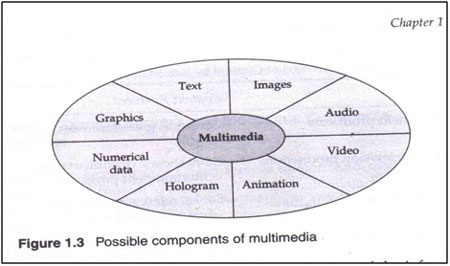
Multimedia Storage Servers & E-Commerce Applications:
- E-Commerce requires robust servers to store and distribute large amounts of digital content to consumers.
- These Multimedia storage servers are large information warehouses capable of handling various content, ranging from books, newspapers, advertisement catalogs, movies, games, & X-ray images.
- These servers, deriving their name because they serve information upon request, must handle large-scale distribution, guarantee security, & complete reliability
i. Client-Server Architecture in Electronic Commerce
- All e-commerce applications follow the client-server model
- Clients are devices plus software that request information from servers or interact known as message passing
- Mainframe computing , which meant for “dump”
- The client server model, allows client to interact with server through request-reply sequence governed by a paradigm known as message passing.
- The server manages application tasks, storage & security & provides scalability-ability to add more clients and client devices (like Personal digital assistants to Pc’s. See in fig.
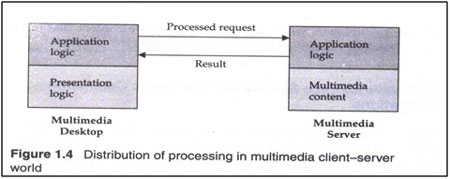
ii. Internal Processes of Multimedia Servers
- The internal processes involved in the storage, retrieval & management of multimedia data objects are integral to e-commerce applications.
- A multimedia server is a hardware & software combination that converts raw data into usable information & then dishes out.
- It captures, processes, manages, & delivers text, images, audio & video.
- It must do to handle thousands of simultaneous users.
- Include high-end symmetric multiprocessors, clustered architecture, and massive parallel systems.
Video Servers & E-Commerce
The electronic commerce applications related to digital video will include
- Telecommunicating and video conferencing
- Geographical information systems that require storage & navigation over maps
- Corporate multimedia servers
- Postproduction studios
- Shopping kiosks.
- Consumer applications will include video-on-demand.
- The figure which is of video–on demand consist vide o servers, is an link between the content providers (media) & transport providers (cable operators)

Information Delivery/Transport & E-Commerce Applications
- Transport providers are principally telecommunications, cable, & wireless industries.
Transport Routers
Information Transport Providers
Information Delivery Methods
•
Telecommunication companies
long-distance telephone lines; local telephone lines
•
Cable television companies
Cable TV coaxial, fiber optic & satellite lines
•
Computer-based on-line servers
Internet; commercial on-line service providers
•
Wireless communications
Cellular & radio networks; paging systems
Consumer Access Devices
Information Consumers
Access Devices
• Computers with audio & video
Personal/desktop computing capabilities
Mobile computing
•
Telephonic devices
Videophone
•
Consumer electronics
Television + set-top box Game systems
• Personal digital assistants (PDAs)
Pen-based computing, voice-driven computing
E-Commerce Consumer applications:
- People needs entertainment on demand including video, games, news on-demand, electronic retailing via catalogs etc.
- Currently now we are taking the video on-demand.
- Why most companies betting heavily on this?
- 93 million homes have television
- Americans spend nearly half their free time watching television
- Every evening, more than one-third of the population is in front of a television
- Sight, sound, and motion combine to make television a powerful means of marketing
1. Consumer Applications and Social Interaction:
- Lessons from history indicate that the most successful technologies are those that make their mark social
- In 1945, in U.S no one had TV. By 1960 about 86percent of households did
- Now contrast with Telephone. Bell invented the telephone in 1876 and by1940, 40% of U.S. households and by 1980 about 95-98 percent of households connected
- Penetration was slower for Telephone than for TV because of the effort needed to set up the wiring infrastructure
The impact of both was good on business, social, consumer behavior and entertainment habits
Radio began in 1960, and by 1989, almost 3 decades later, just 319 radio stations followed the news format
In 1994, their number exceeded 1000
What do Consumers really want?
- They want quality and cost of service
- If a new system requires more steps to do essentially the same things, consumers may resist it
- Some people fit that mold, but most of public prefers to lay back and just watch television and let someone else do the work of figuring out the sequence of television programming
What are Consumers willing to spend?
- According to the video on-demand, consumers get the cable bill at basic charge they will buy
- If it is doubled they will not buy and at the service provider economics will increased then network operators might look to advertises to fill the gap
Delivering products to Consumers
- Packing and distribution must be considered
- Blockbuster video collects the information and shows the typical consumer
- Spends $12 a month on home video expenditures
- Go to video store to select video on limited budget and has time to kill
- Only periodically expends a large sum of money
Consumer Research and E-Commerce
Consumer opinion about interactive television is:
- 46% is willing to pay
- 39% want video phone calls
- 63% would pay for movies on-demand
- 57% would pay for Television shows on-demand
- 78% said their worry about it is that they will pay for something that they previously received free of charge
- 64% are think it make it harder for viewers to protect privacy 41% are tell that it is too confusing to use
Changing business Environment
The traditional business environment is changing rapidly. Many companies are looking outside and within to shape business strategies. These activities include private electronic connections to customers, suppliers, distributors, industry groups etc. I-superhighway will expand this trend so that it allows business to exchange information.
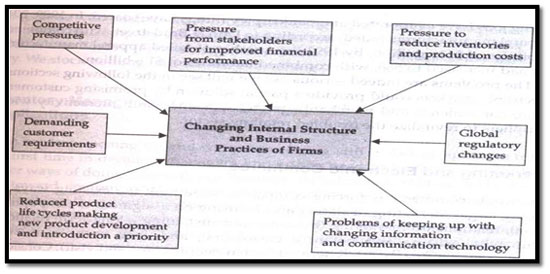
Figure: Pressures influencing business.
E-Commerce and the retail Industry
- Conditions are changing in the “new economy” with respect to the retail industry
- Consumers are demanding lower prices, better quality, and a large selection of in-season goods.
- Retailers are filling their order by slashing back-office costs, reducing profit margins, reducing cycle times. buying more wisely and making huge investments in technology
- Retailers are in the immediate line of fire and were first to bear the brunt of cost cutting
Marketing and E-Commerce
- E-commerce is forcing companies to rethink the existing ways of doing target marketing and even event marketing.
- Interactive marketing is in electronic markets via interactive multimedia catalogs
- Users find moving images more appealing than still image and listening more appealing than reading text on a screen
- Consumer information services are a new type of catalog business
Inventory Management and Organizational Applications
- With borders opening up and companies facing stiff global competition
- Adaptation would include moving to computerized, “paperless” operations to reduce
- Once targeted business process is inventory management, solutions for these processes go by different names
- In manufacturing industry they’re known as just-in- time inventory systems, in the retail as quick response programs, and in transportation industry as consignment tracking systems
Just-in-Time (JIT) Manufacturing
It is viewed as an integrated management system consisting of a number of different management practices dependent on the characteristics of specific plants. The first principle is elimination of all waste (time, materials, labor & equipment). The following management practices are focused factory, reduced set-up times, group technology, total productive maintenance, multifunction employees, uniform workloads, IT purchasing, kanban total quality control & quality circles
Quick Response Retailing (QR)
It is a version of JIT purchasing tailored for retailing. To reduce the risk of being of out of stock, retailers are implementing QR systems. It provides for a flexible response to product ordering and lowers costly inventory levels. QR retailing focuses on market responsiveness while maintaining low levels of stocks. It creates a closed loop consisting of retailer, vendor, & consumer chain,& as consumers make purchases the vendor orders new deliveries from the retailer through its computer network.
Supply Chain Management
- QR and JIT address only part of the overall picture
- Supply Chain Management (SCM) is also called “extending”, which means integrating the internal and external partners on the supply and process chains to get raw materials to the manufacturer and finished products to the consumer
- It includes following functions
Supplier management: The goal is to reduce the number of suppliers and get them to partners
Inventory management: The goal is to shorten the order-ship-bill cycle. When a majority of partners are electronically linked, information faxed or mailed
Distribution management: The goal is to move documents (accurate data) related to shipping
Channel management: The goal is to quickly disseminate information about changing operational conditions (technical, product, and pricing information) to trading partners
Payment management: The goal is to link the company and the suppliers and distributors so that payments can be sent and received electronically
Financial management: The goal is to enable global companies to manage their money in various foreign exchange accounts
Sales force productivity: The goal is to improve the communication flow of information among the sales, customer & production functions
In sum, the supply chain management process increasingly depends on electronic markets
Work group Collaboration Applications:
- A internetwork that enables easy and inexpensive connection of various organizational segments.
- It is to improve communications and information sharing and to gather and analyze competitive data in real-time
- Videoconferencing, document sharing and multimedia e-mail, are expected to reduce travel and encourage telecommuting
- Improves the distribution channel for documents and records to suppliers, collaborators and distributors






